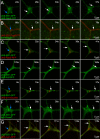Endosomal Wnt signaling proteins control microtubule nucleation in dendrites
- PMID: 32163403
- PMCID: PMC7067398
- DOI: 10.1371/journal.pbio.3000647
Endosomal Wnt signaling proteins control microtubule nucleation in dendrites
Abstract
Dendrite microtubules are polarized with minus-end-out orientation in Drosophila neurons. Nucleation sites concentrate at dendrite branch points, but how they localize is not known. Using Drosophila, we found that canonical Wnt signaling proteins regulate localization of the core nucleation protein γTubulin (γTub). Reduction of frizzleds (fz), arrow (low-density lipoprotein receptor-related protein [LRP] 5/6), dishevelled (dsh), casein kinase Iγ, G proteins, and Axin reduced γTub-green fluorescent protein (GFP) at branch points, and two functional readouts of dendritic nucleation confirmed a role for Wnt signaling proteins. Both dsh and Axin localized to branch points, with dsh upstream of Axin. Moreover, tethering Axin to mitochondria was sufficient to recruit ectopic γTub-GFP and increase microtubule dynamics in dendrites. At dendrite branch points, Axin and dsh colocalized with early endosomal marker Rab5, and new microtubule growth initiated at puncta marked with fz, dsh, Axin, and Rab5. We propose that in dendrites, canonical Wnt signaling proteins are housed on early endosomes and recruit nucleation sites to branch points.
Conflict of interest statement
The authors have declared that no competing interests exist.
Figures








Similar articles
-
Endocytosis of Wnt ligands from surrounding epithelial cells positions microtubule nucleation sites at dendrite branch points.PLoS Biol. 2025 Jan 6;23(1):e3002973. doi: 10.1371/journal.pbio.3002973. eCollection 2025 Jan. PLoS Biol. 2025. PMID: 39761321 Free PMC article.
-
The receptor tyrosine kinase Ror is required for dendrite regeneration in Drosophila neurons.PLoS Biol. 2020 Mar 12;18(3):e3000657. doi: 10.1371/journal.pbio.3000657. eCollection 2020 Mar. PLoS Biol. 2020. PMID: 32163406 Free PMC article.
-
Identification of Proteins Required for Precise Positioning of Apc2 in Dendrites.G3 (Bethesda). 2018 May 4;8(5):1841-1853. doi: 10.1534/g3.118.200205. G3 (Bethesda). 2018. PMID: 29602811 Free PMC article.
-
New steps in the Wnt/beta-catenin signal transduction pathway.Recent Prog Horm Res. 2000;55:225-36. Recent Prog Horm Res. 2000. PMID: 11036939 Review.
-
The role of proton transporters in epithelial Wnt signaling pathways.Pediatr Nephrol. 2011 Sep;26(9):1523-7. doi: 10.1007/s00467-011-1823-z. Epub 2011 Mar 5. Pediatr Nephrol. 2011. PMID: 21380625 Review.
Cited by
-
With the Permission of Microtubules: An Updated Overview on Microtubule Function During Axon Pathfinding.Front Mol Neurosci. 2021 Dec 2;14:759404. doi: 10.3389/fnmol.2021.759404. eCollection 2021. Front Mol Neurosci. 2021. PMID: 34924953 Free PMC article. Review.
-
Scrap and Build for Functional Neural Circuits: Spatiotemporal Regulation of Dendrite Degeneration and Regeneration in Neural Development and Disease.Front Cell Neurosci. 2021 Jan 11;14:613320. doi: 10.3389/fncel.2020.613320. eCollection 2020. Front Cell Neurosci. 2021. PMID: 33505249 Free PMC article. Review.
-
Microtubule polarity is instructive for many aspects of neuronal polarity.Dev Biol. 2022 Jun;486:56-70. doi: 10.1016/j.ydbio.2022.03.009. Epub 2022 Mar 25. Dev Biol. 2022. PMID: 35341730 Free PMC article.
-
Phase separation of microtubule-binding proteins - implications for neuronal function and disease.J Cell Sci. 2024 Dec 15;137(24):jcs263470. doi: 10.1242/jcs.263470. Epub 2024 Dec 13. J Cell Sci. 2024. PMID: 39679446 Review.
-
Microtubules originate asymmetrically at the somatic golgi and are guided via Kinesin2 to maintain polarity within neurons.Elife. 2020 Jul 13;9:e58943. doi: 10.7554/eLife.58943. Elife. 2020. PMID: 32657758 Free PMC article.
References
Publication types
MeSH terms
Substances
Grants and funding
LinkOut - more resources
Full Text Sources
Other Literature Sources
Molecular Biology Databases
Miscellaneous

